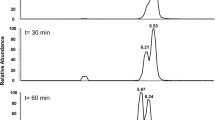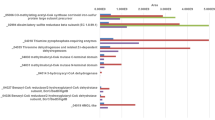Abstract
Short-chain aliphatic epoxides and ketones are two classes of toxic organic compounds formed biogenically and anthropogenically. In spite of their toxicity, these compounds are utilized as primary carbon and energy sources or are generated as intermediate metabolites in the metabolism of other compounds (e.g., alkenes, alkanes, and secondary alcohols) by a number of diverse bacteria. One bacterium capable of using both classes of compounds is the gram-negative aerobe Xanthobacter strain Py2. Studies of epoxide and ketone (acetone) metabolism by Xanthobacter strain Py2 have revealed a central role for CO2 in these processes. Both classes of compounds are metabolized by carboxylation reactions that produce β-keto acids as products. The epoxide- and ketone-converting enzymes are distinct carboxylases with molecular properties and cofactor requirements unprecedented for other carboxylases. Epoxide carboxylase is a four-component multienzyme complex that requires NADPH and NAD+ as cofactors. In the course of epoxide carboxylation, a transhydrogenation reaction occurs wherein NADPH undergoes oxidation and NAD+ undergoes reduction. Acetone carboxylase is a multimeric (three-subunit) ATP-dependent enzyme that forms AMP and inorganic phosphate as ATP hydrolysis products in the course of acetone carboxylation. Recent studies have demonstrated that acetone metabolism in diverse anaerobic bacteria (sulfate reducers, denitrifiers, phototrophs, and fermenters) also proceeds by carboxylation reactions. ATP-dependent acetone carboxylase activity has been demonstrated in cell-free extracts of the anaerobic acetone-utilizers Rhodobacter capsulatus, Rhodomicrobium vannielii, and Thiosphaera pantotropha. These studies have identified new roles for CO2 as a cosubstrate in the metabolism of two classes of important xenobiotic compounds. In addition, two new classes of carboxylases have been identified, the investigation of which promises to reveal new insights into biological strategies for the fixation of CO2 to organic substrates.
Similar content being viewed by others
Author information
Authors and Affiliations
Additional information
Received: 13 August 1997 / Accepted: 6 October 1997
Rights and permissions
About this article
Cite this article
Ensign, S., Small, F., Allen, J. et al. New roles for CO2 in the microbial metabolism of aliphatic epoxides and ketones. Arch Microbiol 169, 179–187 (1998). https://doi.org/10.1007/s002030050558
Issue Date:
DOI: https://doi.org/10.1007/s002030050558




